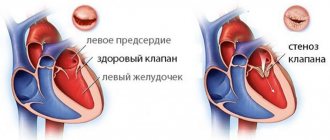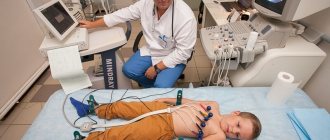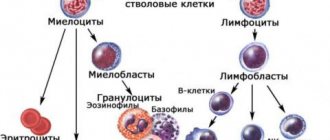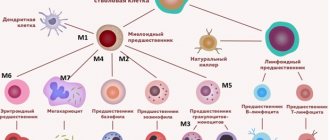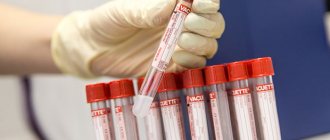Publications in the media
Mitral valve prolapse (MVP) is a pathological sagging (bending) of one or both mitral valve leaflets into the left atrium during left ventricular systole. Statistical data. MVP is found in 3–8% of people in the general population (apparently, the data is overestimated). Manifestations of MVP are first recorded at the age of 10–16 years; after 10 years, girls are observed 2 times more often.
Etiology. MVP can be primary or secondary • Primary MVP •• A disease inherited in an autosomal dominant manner with myxomatous deformation of the mitral valve leaflets •• MVP is also observed in patients with Marfan syndrome and other congenital connective tissue diseases, such as Ehlers-Danlos syndrome, elastic pseudoxanthoma, osteogenesis imperfecta •• In the occurrence of MVP, exposure to toxic agents on the fetus on the 35–42nd day of pregnancy may also be important • Secondary MVP can occur with: •• IHD (ischemia of the papillary muscles) •• rheumatism (post-infectious sclerotic changes) • • hypertrophic cardiomyopathy (disproportionally small left ventricle, change in the location of the papillary muscles).
Pathogenesis • Primary MVP •• Myxomatous degeneration of collagen leads to excessive accumulation of mucopolysaccharides in the middle spongy part of the mitral valve leaflets and its hyperplasia, which causes the appearance of break areas in the fibrous part of the valve. Local replacement of the elastic fibrous tissue of the valve leaflet with a weak and inelastic spongy structure leads to the fact that during systole, under the influence of blood pressure from the left ventricle, the leaflet bulges towards the left atrium (prolapses) •• In the occurrence of primary MVP in Marfan syndrome, it is also important dilatation of the annulus fibrosus of the mitral valve - it does not decrease by 30% in systole, as is normal, which leads to protrusion of one or both leaflets into the cavity of the left atrium • Secondary MVP occurs as a result of thinning and elongation of the tendon threads or their separation or dilatation of the fibrous ring. Lengthening of the tendon threads, separation of part of them lead to the fact that the leaflet is not held in place and begins to prolapse into the left atrium • If the mitral valve leaflet is excessively bowed, mitral regurgitation may occur with dilatation of the left atrium and left ventricle. It should be noted that MVP can be combined with prolapse of other valves: tricuspid valve prolapse in 40% of cases, pulmonary valve prolapse in 10%, aortic valve prolapse in 2%. In this case, in addition to mitral valve insufficiency, manifestations of insufficiency of the corresponding valve will occur. There is often a combination of MVP with other congenital anomalies of the heart - ASD, additional conduction pathways (usually left-sided).
Clinical manifestations • Complaints •• In most cases, MVP is asymptomatic and is detected by chance during a preventive examination •• With more severe prolapse, patients complain of palpitations (ventricular extrasystole, paroxysmal supraventricular tachycardia, less often ventricular tachycardia) •• A common complaint is pain in the chest. It can be either atypical or typical anginal due to spasm of the coronary arteries or ischemia as a result of tension of the papillary muscles •• Shortness of breath during physical exertion, fatigue are also noted by patients with MVP •• Extremely rare manifestations are visual impairment as a result of thromboembolism of the retinal vessels, and also transient ischemic attacks as a result of cerebral thromboembolism. In the occurrence of embolic complications, importance is attached to the separation of fibrin threads located on the atrial side of the mitral valve •• Often the above-described complaints are accompanied by psycho-emotional lability • Upon examination, concomitant congenital abnormalities of the chest shape can be identified - kyphoscoliosis, funnel-shaped chest, pathologically straightened back, reduced anteroposterior chest size cells or signs of Marfan syndrome • Auscultation of the heart (a “silent” form of MVP is possible) •• The main auscultatory sign of MVP is a short mid-systolic high-frequency click (pathognomonic). It appears as a result of sagging of the mitral valve leaflets in systole into the cavity of the left atrium and their sharp tension •• The systolic click may be followed by a mid- or high-frequency late systolic murmur, better heard at the apex of the heart •• To clarify the manifestations of MVP, dynamic auscultation of the heart is used •• • Changes in left ventricular end-diastolic volume result in changes in the timing of the click and murmur. All maneuvers that contribute to a decrease in end-diastolic volume, an increase in heart rate, or a decrease in resistance to ejection from the left ventricle lead to MVP appearing earlier (the click noise approaches the first sound). All maneuvers that increase blood volume in the left ventricle, reduce myocardial contractility or increase afterload increase the time from the beginning of systole to the appearance of a click noise (moves back to the second sound) ••• In the supine position, the click occurs later, the noise is short ••• In the position standing, the click occurs earlier, and the noise is longer ••• In the squatting position, the click occurs later, and the noise is shorter (may even disappear). Instrumental data • Usually no changes are detected on the ECG in patients with MVP. Of the detected deviations, depression of the ST segment or negative T waves in leads III, aVF are most often noted. These changes may reflect ischemia of the inferior wall of the left ventricle as a result of tension in the posterior papillary muscle due to leaflet prolapse. In patients with ECG changes, cardiac arrhythmias also occur. Some patients experience prolongation of the QT interval. Recording an ECG after taking beta-blockers increases the specificity of this method • EchoCG •• In one-dimensional mode, the “hammock” symptom is detected - sagging of one or both leaflets in systole by more than 3 mm •• In two-dimensional mode, sagging of the mitral valve leaflets into the cavity of the left atrium in systole is detected left ventricle, thickening of the leaflets more than 5 mm in diastole, lengthening of the tendon filaments, lengthening of the leaflets, dilatation of the fibrous ring •• There are three degrees of MVP, determined in a four-chamber section ••• I degree (minor) - sagging of the leaflets into the cavity of the left atrium up to 5 mm ••• II degree (moderate) - sagging of the leaflets into the cavity of the left atrium 5-10 mm ••• III degree (severe) - sagging of the leaflets into the cavity of the left atrium more than 10 mm •• Doppler examination can reveal a regurgitation jet in the left atrium. With severe MVP, dilatation of the left atrium and left ventricle occurs, detected in one- and two-dimensional modes. It should be remembered that in the presence of typical auscultatory signs of MVP, its EchoCG signs may be absent in 10% of patients. When conducting the study, you should remember about other congenital heart defects (in particular, ASD). Differential diagnosis • Mitral valve insufficiency of rheumatic origin • Isolated aneurysm of the interatrial septum • Isolated tricuspid valve prolapse • VSD.
TREATMENT Management tactics • Treatment of the underlying disease in secondary MVP • Risk groups for the development of complications (patients with severe systolic murmur, thickened prolapsed mitral valve leaflets, left ventricular hypertrophy, rhythm disturbances, fainting) undergo regular ECG, echocardiography • Prevention of endocarditis is indicated for persons with severe systolic murmur. Treatment of various options • For asymptomatic MVP without signs of mitral valve insufficiency, there is no need for treatment •• The patient should be given recommendations for normalizing lifestyle, optimizing physical activity (a decrease in the tone of the sympathetic nervous system can lead to a decrease in valvular dysfunction) •• EchoCG is recommended -control once every 1–2 years •• It is necessary to avoid drinking strong tea, coffee, alcohol, as well as smoking • For severe MVP •• If there are symptoms of MVP such as tachycardia, palpitations, chest pain, is prescribed -adrenergic blockers in small doses (for example, propranolol at a dose of 30–60 mg/day) •• In case of dilatation of the left atrium and left ventricle, prolongation of the QT interval, a history of fainting, dilatation of the initial part of the aorta, physical activity is prohibited •• Prevention is recommended infective endocarditis using amoxicillin •• For symptoms of embolization, acetylsalicylic acid is prescribed at a dose of 80–325 mg/day •• With significant changes in hemodynamics, increasing symptoms of mitral valve insufficiency, mitral valve replacement or annuloplasty is performed.
Prognosis and complications . Typically, MVP is benign. Complications of MVP most often occur in patients with systolic murmur, thickened, elongated mitral leaflets, or enlarged left ventricular cavity or left atrium. Complications include: • separation of tendon threads • severe mitral valve insufficiency (0.06%) • fibrin deposition on the mitral valve leaflets • cardiac arrhythmias • cerebrovascular pathology (0.02%) • infectious myocarditis (0.02%) • sudden cardiac arrest death (0.06% of cases with severe mitral valve insufficiency). Synonyms • Systolic click-murmur syndrome • Barlow's syndrome • Inflated mitral valve syndrome. Reduction. MVP - mitral valve prolapse.
ICD-10 • I34.1 Prolapse [prolapse] of the mitral valve
The International Statistical Classification of Diseases and Problems, 10th revision (ICD-10), currently in use, is a normative document that ensures the formation of unified statistical control over the activities of medical institutions, assessment of the epidemiological situation in the country, and allows for the unity and comparability of incoming medical data [1] . ICD-10 is one of the important methodological tools for processing statistical data, which is extremely necessary for automating basic planning, regulatory and management work [2]. Unfortunately, this classification contains errors, both in the structural design of clinical sections and in the coding of a number of diseases. Some of the diagnoses that exist in it sound somewhat absurd; there is a confusion of placement of individual polyetiological diseases and syndromes in sections, which are often located in chapters that have a very indirect relationship to this nosology. In addition, many nosological forms, syndromes and symptoms that are currently common are not included in the accepted classification, which undoubtedly significantly limits the practical application of ICD-10.
The variety of different forms of diseases complicates the structure of the classification, so the latest revision has become much larger in volume and was accompanied by extensive guidelines, unfortunately, often without taking into account clinical practice. As a result, some of the clinical diagnoses ended up within the limits of unrefined conditions or conditions that were not sufficiently differentiated, and not in the headings or subheadings of the corresponding sections of the classification.
A number of difficulties arise with regard to the topographic classifications and terms used in ICD-10, many of which are imprecise, contradictory and do not correspond to clinical practice. Unfortunately, it should be noted that ICD-10 cannot currently be recommended as a model for terminology and recording of clinical diagnoses in medical records and other medical records.
To solve the problem of uniform standardization of medical diagnoses and statistical records, back in the late 70s of the last century, the idea arose of creating a “family” of classifications of diseases and health problems based on the ICD, adapted to a specific specialty, taking into account modern achievements of medical science.
Classification options for dentists, oncologists, dermatologists, rheumatologists and orthopedists, pediatricians, psychiatrists, and general practitioners have been published and recommended by WHO. Unfortunately, in the field of andrology there is still no unified classification [2].
Currently, the Research Institute of Urology is developing printed and electronic versions of a similar classification for urology and andrology, which is based on three-digit and four-digit ICD-10 codes. The coding system for urological and andrological diseases is presented in the form of a tree, where each subnode refines the information of the previous node. When forming a subnode, a number from zero to nine is added to the main code through a dot. The proposed system also provides for taking into account the localization of the pathological process, its stage and/or phase [3-5].
The creation of a printed and electronic version of a new unified clinical and statistical classification of andrological diseases will allow:
- facilitate data collection and improve the analysis of statistical material on andrology by increasing the reliability of statistical information and reducing the number of errors due to inconsistency of clinical diagnoses with ICD-10 diagnoses;
- provide a detailed assessment of the complexity of clinical cases and final treatment results when providing specialized (including high-tech) medical care;
- standardize the formulation of andrological diagnoses in medical documents and computer information systems of health authorities of the Russian Federation;
- improve the economic and statistical analysis of the provision of medical care in the field of andrology in the interests of healthcare of the Russian Federation, individual medical institutions and compulsory health insurance (CHI);
- optimize costs for diagnosis and treatment of andrological diseases.
It should be taken into account that andrological diseases, as a rule, are multi-etiological and many of them do not fit only into the framework of the block “Diseases of the male genital organs”. The modern concept of andrology is, of course, based on interdisciplinary interaction and is at the intersection of related medical disciplines (urology, endocrinology, psychiatry, genetics, neurology, therapy, etc.). Therefore, andrological diseases are heterogeneous in nature and are widely represented in different sections of ICD-10 (Table 1).
Table 1. General classification of andrological diseases according to ICD-10 and proposals for its correction
| ICD-10 code | Nosology | Correction and comments |
| 1 | 2 | 3 |
| A54.0 | Gonococcal infection of the lower genitourinary tract without abscessation of the periurethral or accessory glands | |
| A54.1 | Gonococcal infection of the lower genitourinary tract with abscess formation of the periurethral and accessory glands | |
| A56 | Other chlamydial sexually transmitted diseases | |
| A56.0 | Chlamydial infections of the lower genitourinary tract | |
| A56.1 | Chlamydial infections of the pelvic organs and other genitourinary organs | |
| A56.2 | Chlamydial infection of the genitourinary tract, unspecified | |
| A56.8 | Chlamydial infections, sexually transmitted infections, other localization | |
| A59 | Trichomoniasis | |
| A59.0 | Urogenital trichomoniasis | |
| A60 | Anogenital herpetic viral infection (herpes simplex) | |
| A60.0 | Herpetic infections of the genitals and genitourinary tract | |
| D17.6 | Benign neoplasm of adipose tissue of the spermatic cord | |
| E28.0 | Excess estrogen | Controversial diagnosis. It has no clinical use in men. |
| E28.1 | Excess androgens | Controversial diagnosis. Not all specialists accept the upper limits of normal. |
| E29 | Testicular dysfunction | Controversial diagnosis. Has no clinical use. |
| E29.0 | Testicular hyperfunction | Controversial diagnosis. Has no clinical use. |
| E29.1 | Testicular hypofunction | Controversial diagnosis. Has no clinical use. |
| E29.8 | Other types of testicular dysfunction | Controversial diagnosis. Has no clinical use. |
| E29.9 | Testicular dysfunction, unspecified | Controversial diagnosis. Has no clinical use. |
| E89.5 | Testicular hypofunction after medical procedures | Controversial diagnosis. Has no clinical use. |
| F52 | Sexual dysfunction not due to organic disorders or diseases | We propose to reduce this diagnosis due to its uncertainty, and refer all cases of erectile dysfunction to paragraph N48.4. |
| F52.0 | Lack or loss of sexual desire | |
| F52.1 | Aversion to sexual intercourse and lack of sexual pleasure | |
| F52.2 | Lack of genital response | Controversial diagnosis. It has no clinical use in men. |
| F52.3 | Orgasmic dysfunction | |
| F52.4 | Premature ejaculation | Correction: F52.4: Ejaculation disorders |
| Correction: F52.4.0 Premature ejaculation. | ||
| Correction: F52.4.1 Delayed ejaculation. | ||
| Correction: F52.4.2 Retrograde ejaculation. | ||
| Correction: F52.4.3 Anejaculation. | ||
| F64.0 | Transsexualism | |
| F64.2 | Gender identity disorder in childhood | |
| F64.8 | Other gender identity disorder | |
| F64.9 | Gender identity disorder, unspecified | |
| F65 | Sexual preference disorders | |
| F65.6 | Multiple disorders of sexual preference | |
| F65.8 | Other disorders of sexual preference | |
| F65.9 | Disorder of sexual preference, unspecified | |
| F66 | Psychological and behavioral disorders associated with sexual development and orientation | |
| F66.0 | Sexual maturation disorder | |
| F66.1 | Egodystonic sexual orientation | |
| F66.2 | Sexual relationship disorder | Controversial diagnosis. Correction: sexual disharmony. |
| F66.8 | Other psychosexual developmental disorders | |
| F66.9 | Psychosexual development disorder, unspecified | |
| F68.0 | Exaggeration of somatic symptoms for psychological reasons | |
| F83 | Mixed specific psychological development disorders | |
| F84 | General psychological disorders | |
| I86.1 | Varicose veins of the scrotum (varicocele) | |
| Correction: I86.1.0 Varicocele on the left. | ||
| Correction: I86.1.1 Varicocele on the right. | ||
| Correction: I86.1.2 Varicocele hemodynamic type 1 (renotesticular type of reflux). | ||
| Correction: I86.1.3 Varicocele hemodynamic type 2 (ileotesticular type of reflux). | ||
| Correction: I86.1.4 Varicocele hemodynamic type 3 (mixed type of reflux). | ||
| Correction: I86.1.5 Bilateral varicocele. | ||
| N34.0 | Urethral abscess | |
| N34.1 | Nonspecific urethritis | |
| N34.2 | Other urethritis | |
| N35 | Urethral stricture | |
| N35.0 | Post-traumatic urethral stricture | |
| N35.1 | Post-infectious urethral stricture, not elsewhere classified | |
| N35.8 | Other urethral stricture | |
| N35.9 | Urethral stricture, unspecified | |
| N36 | Other urethral diseases | |
| N36.0 | Urethral fistula | |
| N36.1 | Urethral diverticulum | |
| Correction: N36.2 Stenosis of the external urethral meatus. | ||
| Correction: N36.3 Obliteration of the urethra. | ||
| N36.8 | Other specified diseases of the urethra | |
| N36.9 | Urethral disease, unspecified | |
| N37* | Lesions of the urethra in diseases classified elsewhere | |
| N37.0* | Urethritis in diseases classified elsewhere | |
| N37.8* | Other lesions of the urethra in diseases classified elsewhere | |
| N39 | Other diseases of the urinary system | |
| N39.0 | Urinary tract infection without established localization | |
| N39.3 | Involuntary urination | |
| N39.4 | Other specified types of urinary incontinence | |
| N39.8 | Other specified diseases of the urinary system | |
| N39.9 | Urinary system disorder, unspecified | |
| N40 | Benign prostatic hyperplasia | |
| Correction: N40.0 With impaired quality of urination. | ||
| Correction: N40.1 Without affecting the quality of urination. | ||
| N41.0 | Acute prostatitis | |
| N41.1 | Chronic prostatitis | |
| Correction: N41.1.0 Chronic bacterial prostatitis. | ||
| Correction: N41.1.1 Chronic abacterial prostatitis. | ||
| Correction: N41.1.1.1 Abacterial CP with the presence of inflammation. | ||
| Correction: N41.1.1.2 Abacterial CP without signs of inflammation. | ||
| Correction: N41.1.2 Asymptomatic chronic prostatitis. | ||
| N41.2 | Prostate abscess | |
| N41.3 | Prostatocystitis | Controversial diagnosis. Has no clinical use. We propose to reduce this diagnosis. Correction: N41.3 Colliculitis. |
| Correction: N41.4 Sclerosis of the prostate gland. | ||
| N41.8 | Other inflammatory diseases of the prostate gland and seminal vesicles | |
| N41.9 | Inflammatory disease of the prostate, unspecified | |
| N42 | Other prostate diseases | |
| N42.0 | Prostate stones | Controversial diagnosis. Has no clinical use. We propose to reduce this diagnosis. Correction: Simple prostate cyst. |
| N42.1 | Congestion and hemorrhage in the prostate gland | Controversial diagnosis. Has no clinical use. We propose to reduce this diagnosis. |
| N42.2 | Prostate atrophy | |
| N42.8 | Other specified prostate diseases | |
| N42.9 | Prostate disease, unspecified | |
| N43 | Hydrocele and spermatocele | We propose in paragraph N43 to consider only hydrocele. |
| N43.0 | Hydrocele encyscum | Controversial diagnosis. Has no clinical use. We propose to reduce this diagnosis. Correction: Hydrocele on the left. |
| N43.1 | Infected hydrocele | Correction: Hydrocele on the right. |
| N43.2 | Other forms of hydrocele | Correction: Infected hydrocele. |
| N43.3 | Hydrocele, unspecified | Correction: Uninfected hydrocele. |
| N43.4 | Spermatocele | Correction: Hydrocele, unspecified. |
| Correction: N43.5 Spermatocele. | ||
| N44 | Testicular torsion | Correction: N44.0 Testicular torsion. |
| Correction: N44.1 Torsion of Morgagni's hydatid. | ||
| N45 | Orchitis and epididymitis | |
| N45.0 | Orchitis, epididymitis and epididymo-orchitis with abscess | Correction: Unilateral orchitis, epididymitis and epididymo-orchitis with abscess. |
| N45.9 | Orchitis, epididymitis and epididymo-orchitis without mention of abscess | Correction: N45.1 Unilateral orchitis, epididymitis and epididymo-orchitis without abscess. |
| Correction: N45.2 Bilateral orchitis, epididymitis and epididymo-orchitis with abscess. | ||
| Correction: N45.3 Bilateral orchitis, epididymitis and epididymo-orchitis without abscess. | ||
| N46 | Male infertility | Due to the polyetiological nature of the factors leading to male infertility, we propose to differentiate these forms depending on the causative factors. |
| Correction: N46.0 Male infertility caused by dysfunction at the level of the hypothalamus/pituitary gland. | ||
| Correction: N46.1 Male infertility caused by dysfunction at the testicular level. | ||
| Correction: N46.2 Male infertility caused by dysfunction of the efferent seminal tract and accessory sex glands. | ||
| Correction: N46.3 Male infertility caused by an ejaculation defect. | ||
| Correction: N46.4 Male infertility caused by an immunological factor. | ||
| Correction: N46.5 Male infertility caused by dysfunction of other androgen target organs. | ||
| Correction: N46.6 Male infertility, idiopathic form. | ||
| ALTERNATIVE CLASSIFICATION OF MALE INFERTILITY | ||
| Correction: N46.0 Male infertility is caused by a damaging external factor. | ||
| Correction: N46.1 Male infertility is caused by chromosomal pathology. | ||
| Correction: N46.2 Male infertility is caused by an anomaly in the structure or development of the male genital organs. | ||
| Correction: N46.3 Male infertility is caused by an endocrine factor. | ||
| Correction: N46.4 Male infertility is caused by infectious and inflammatory diseases of the male genital organs. | ||
| Correction: N46.5 Male infertility is caused by an immunological factor. | ||
| Correction: N46.6 Male infertility is caused by an iatrogenic factor. | ||
| Correction: N46.7 Male infertility is caused by an isolated pathology of seminal plasma. | ||
| Correction: N46.8 Idiopathic male infertility. | ||
| N47 | Excessive foreskin, phimosis and paraphimosis | Correction: N47.0 Excessive foreskin. |
| Correction: N47.1 Phimosis. | ||
| Correction: N47.2 Paraphimosis. | ||
| Correction: N47.3 Functional paraphimosis. | ||
| N48 | Other diseases of the penis | |
| N48.0 | Leukoplakia of the penis | |
| N48.1 | Balanoposthitis | |
| Correction: N48.1.0 Acute balanoposthitis. | ||
| Correction: N48.1.1 Chronic balanoposthitis. | ||
| N48.2 | Other inflammatory diseases of the penis | |
| Correction: N48.2.0 Cavernit. | ||
| Correction: N48.2.1 Serous cavernitis. | ||
| Correction: N48.2.2 Purulent cavernitis. | ||
| Correction: N48.2.3 Cavernous fibrosis. | ||
| N48.3 | Priapism | |
| Correction: N48.3.0 Arterial priapism. | ||
| Correction: N48.3.1 Ischemic priapism. | ||
| Correction: N48.3.2 Nocturnal intermittent priapism. | ||
| N48.4 | Impotence of organic origin | We suggest making a correction: Psychosomatic syndrome of erectile dysfunction. |
| Correction: N48.4.0 Erectile dysfunction with a predominance of the organic component. | ||
| Correction: N48.4.1 Erectile dysfunction with a predominance of the psychogenic component. | ||
| N48.5 | Penile ulcer | |
| N48.6 | Balanitis | |
| Correction: N48.6.0 Acute balanitis. | ||
| Correction: N48.6.1 Chronic balanitis. | ||
| Correction: N48.6.2 Xerotic balanitis obliterans. | ||
| N48.8 | Other specified diseases of the penis | |
| Correction: N48.8.0 Small penis. | ||
| Correction: N48.8.1 Ectopia of the penis. | ||
| Correction: N48.8.2 Double penis. | ||
| Correction: N48.8.3 Webbed penis. | ||
| Correction: N48.8.4 Retractile penis. | ||
| Correction: N48.8.5 Hidden penis. | ||
| Correction: N48.8.6 Peyronie's disease. | ||
| Correction: N48.8.6.0 Peyronie's disease in the active stage. | ||
| Correction: N48.8.6.1 Peyronie's disease in the functional stage. | ||
| N48.9 | Disease of the penis, unspecified | |
| N49 | Inflammatory diseases of the male genital organs, not elsewhere classified | |
| N49.0 | Inflammatory diseases of the seminal vesicle | Correction: Vesiculitis. |
| Correction: N49.0.0 Acute vesiculitis. | ||
| Correction: N49.0.1 Chronic vesiculitis. | ||
| N49.1 | Inflammatory diseases of the spermatic cord, tunica vaginalis and vas deferens | |
| N49.2 | Inflammatory diseases of the scrotum | |
| Correction: N49.3 Fournier's gangrene. | ||
| N49.8 | Inflammatory diseases of other specified male genital organs | |
| N49.9 | Inflammatory diseases of the unspecified male genital organ | |
| N50 | Other diseases of the male genital organs | |
| N50.0 | Testicular atrophy | |
| N50.1 | Vascular disorders of the male genital organs | Controversial diagnosis. Has no clinical significance. |
| Correction: N50.2 Contact dermatitis of the genitals. | ||
| N50.8 | Other specified diseases of the male genital organs | |
| N50.9 | Male genital disease, unspecified | |
| N51* | Lesions of the male genital organs in diseases classified elsewhere | |
| N51.0* | Lesions of the prostate gland in diseases classified elsewhere | |
| N51.1* | Lesions of the testicle and its appendages in diseases classified elsewhere | |
| N51.2* | Balanitis in diseases classified elsewhere | |
| N51.8* | Other lesions of the male genital organs in diseases classified elsewhere | |
| N51.8* | Other lesions of the male genital organs in diseases classified elsewhere | |
| N94.1 | Dyspareunia | |
| N99 | Disorders of the genitourinary system after medical procedures not classified elsewhere | |
| N99.1 | Postoperative urethral stricture | |
| N99.8 | Other disorders of the genitourinary system after medical procedures | |
| N99.9 | Disorders of the genitourinary system after medical procedures, unspecified | |
| Q53 | Undescended testicle | |
| Q53.0 | Ectopic testicle | |
| Q53.1 | Unilateral undescended testicle | |
| Q53.2 | Bilateral undescended testicle | |
| Correction: Q53.3 Pseudocryptorchidism. | ||
| Q53.9 | Undescended testicle, unspecified | |
| Q54 | Hypospadias | |
| Q54.0 | Hypospadias of the glans penis | |
| Q54.1 | Penile hypospadias | |
| Q54.2 | Hypospadias penis-scrotum | |
| Q54.3 | Perineal hypospadias | |
| Q54.4 | Congenital curvature of the penis | |
| Q54.8 | Other hypospadias | Correction: Hypospadias without hypospadias. |
| Q54.9 | Hypospadias, unspecified | |
| Q55 | Other congenital anomalies [malformations] of the male genital organs | |
| Q55.0 | Absence and aplasia of the testicle | |
| Q55.1 | Testicular and scrotal hypoplasia | |
| Q55.2 | Other congenital anomalies of the testicle and scrotum | |
| Correction: Q55.2.0 Monorchidism. | ||
| Correction: Q55.2.0.0 Monorchidism on the right. | ||
| Correction: Q55.2.0.1 Monorchidism on the left. | ||
| Correction: Q55.2.1 Polyorchidism. | ||
| Correction: Q55.2.2 Synorchidism. | ||
| Q55.3 | Atresia of the vas deferens | |
| Q55.4 | Other congenital anomalies of the vas deferens, epididymis, spermatic cord and prostate | |
| Q55.5 | Congenital absence and aplasia of the penis | |
| Q55.6 | Other congenital anomalies of the penis | |
| Q55.8 | Other specified congenital anomalies of the male genital organs | |
| Q55.9 | Congenital anomaly of the male genital organs, unspecified | |
| Q56 | Sex ambiguity and pseudohermaphroditism | |
| Q56.0 | Hermaphroditism, not elsewhere classified | |
| Q56.1 | Male pseudohermaphroditism, not elsewhere classified | |
| Q56.3 | Pseudohermaphroditism, unspecified | |
| Q56.4 | Gender ambiguity, unspecified | |
| Q64 | Other congenital anomalies [malformations] of the urinary system | |
| Q64.0 | Epispadias | |
| Correction: Q64.0.0 Epispadias of the head. | ||
| Correction: Q64.0.1 Penile epispadias. | ||
| Correction: Q64.0.2 Total epispadias. | ||
| Q64.1 | Bladder exstrophy | |
| Q64.2 | Congenital posterior urethral valves | |
| Q64.3 | Other types of atresia and stenosis of the urethra and bladder neck | |
| Q64.5 | Congenital absence of the bladder and urethra | |
| Q64.7 | Other congenital anomalies of the bladder and urethra | |
| Q64.8 | Other specified congenital anomalies of the urinary system | |
| Q64.9 | Congenital anomaly of the urinary system, unspecified | |
| Q89.7 | Multiple congenital anomalies not elsewhere classified | |
| Q89.8 | Other specified congenital anomalies | |
| Q89.9 | Congenital anomaly, unspecified | |
| Q92.7 | Triploidy and polyploidy | |
| Q95.3 | Balanced sexual/autosomal rearrangements in a normal individual | |
| Q98.0 | Klinefelter syndrome, karyotype 47,XXY | |
| Q98.1 | Klinefelter syndrome, male with more than two X chromosomes | |
| Q98.2 | Klinefelter syndrome, man with 46,XX karyotype | |
| Q98.3 | Another man with a 46,XX karyotype | |
| Q98.4 | Klinefelter's syndrome, unspecified | |
| Q98.5 | Karyotype 47,XYU | |
| Q98.6 | A man with structurally altered sex chromosomes | |
| Q98.7 | Male with mosaic sex chromosomes | |
| Q98.8 | Other specified sex chromosome abnormalities, male phenotype | |
| Q98.9 | Sex chromosome abnormality, male phenotype, unspecified | |
| Q99 | Other chromosomal abnormalities not elsewhere classified | |
| Q99.0 | Mosaic [chimera] 46,ХХ/46,ХY | |
| Q99.1 | 46.XX true hermaphrodite | |
| Q99.2 | Fragile X chromosome | |
| Q99.8 | Other specified chromosomal abnormalities | |
| Q99.9 | Chromosomal abnormality, unspecified | |
| R10.2 | Pain in the pelvis and perineum | |
| R30.9 | Painful urination, unspecified | |
| R32 | Urinary incontinence, unspecified | |
| R33 | Urinary retention | |
| R36 | Discharge from the urethra | |
| R39 | Other symptoms and signs related to the urinary system | |
| R39.1 | Other difficulties related to urination | |
| R39.8 | Other and unspecified symptoms and signs related to the urinary system | |
| R44.8 | Other and unspecified symptoms and signs relating to general sensations and perceptions | |
| R45 | Symptoms and signs related to emotional state | |
| R45.0 | Nervousness | |
| R45.1 | Anxiety and agitation | |
| R45.2 | State of anxiety due to failures and misfortunes | |
| R45.3 | Demoralization and apathy | |
| R45.4 | Irritability and anger | |
| R45.7 | State of emotional shock and stress, unspecified | |
| R45.8 | Other symptoms and signs related to emotional state | |
| R46 | Symptoms and signs related to appearance and behavior | |
| R52.1 | Constant, unrelieved pain | |
| R52.2 | Other constant pain | |
| R52.9 | Unspecified pain | |
| R53 | Malaise and fatigue | |
| R54 | Old age | Controversial diagnosis. |
| R62 | Lack of expected normal physiological development | |
| R62.0 | Delayed developmental milestones | |
| R62.8 | Other delays in expected normal physiological development | |
| R62.9 | Lack of expected normal physiological development, unspecified | |
| S30.2 | Bruise of the external genitalia | |
| S31.2 | Open wound of the penis | |
| S31.3 | Open wound of the scrotum and testicles | |
| S31.5 | Open wound of other and unspecified external genitalia | |
| S38.0 | Crushing of the external genitalia | |
| S38.2 | Traumatic amputation of the external genitalia | |
| T19 | Foreign body in the genitourinary tract | |
| T19.0 | Foreign body in the urethra | |
| T19.8 | Foreign body in another or several parts of the genitourinary tract | |
| T19.9 | Foreign body in an unspecified part of the genitourinary tract | |
| Z84.2 | Family history of other diseases of the genitourinary system | |
| Z87.4 | Personal history of diseases of the genitourinary system | |
| Z90.7 | Acquired absence of sexual organ(s) | |
| Z99.8 | Dependence on other auxiliary mechanisms and devices | |
This summary table shows those symptoms, syndromes and nosological forms according to ICD10 that a practicing specialist in the field of andrology encounters in real practice. At the same time, in our opinion, some of them no longer correspond to the modern understanding of pathophysiological processes and require terminological and classification clarification (right column).
Naturally, the above classification needs to be supplemented and refined, and fundamental amendments be made taking into account interdisciplinary interaction. With our publication, we would like to provoke a discussion among specialists in the field of andrology, the main goal of which would be to create a single, integral classification of andrological diseases. This is undoubtedly valuable and convenient for medical practitioners, health authorities, scientific research, and insurance companies. We will be grateful for your comments and remarks, which can be sent to the email address
Key words: ICD-10, andrological diseases, clinical and statistical classification.
Keywords : ICD-10, andrology diseases, clinical and statistical classification.
Literature
- International classification of diseases and related health problems. WHO, 1992
- Order of the Ministry of Health of the Russian Federation dated May 27, 1997 No. 170 (as amended on January 12, 1998) “On the transition of health authorities and institutions of the Russian Federation to the international statistical classification of diseases and health-related problems of the X revision.”
- Sivkov A.V., Kakorina E.P., Keshishev N.G. Unified clinical and statistical classification of urological diagnoses // Materials of the XI Congress of Urologists of Russia. M. 2007. pp. 598-599.
- Unified clinical and statistical classification of urolithiasis / Apolikhin O.I., Dzeranov N.K., Sivkov A.V., Kakorina E.P., Keshishev N.G. // Urology. 2008. No. 6. P. 3-6.
- On the creation of a unified clinical and statistical classification of oncological urological diseases using the example of kidney tumors / Apolikhin O.I., Sivkov A.V., Chernyshev Yu.V., Kakorina E.P., Keshishev N.G., Zhernov A.A. // Experimental and clinical urology. 2010. No. 1. pp. 23-28.
| Attached file | Size |
| Article in PDF format | 414.14 kb |
